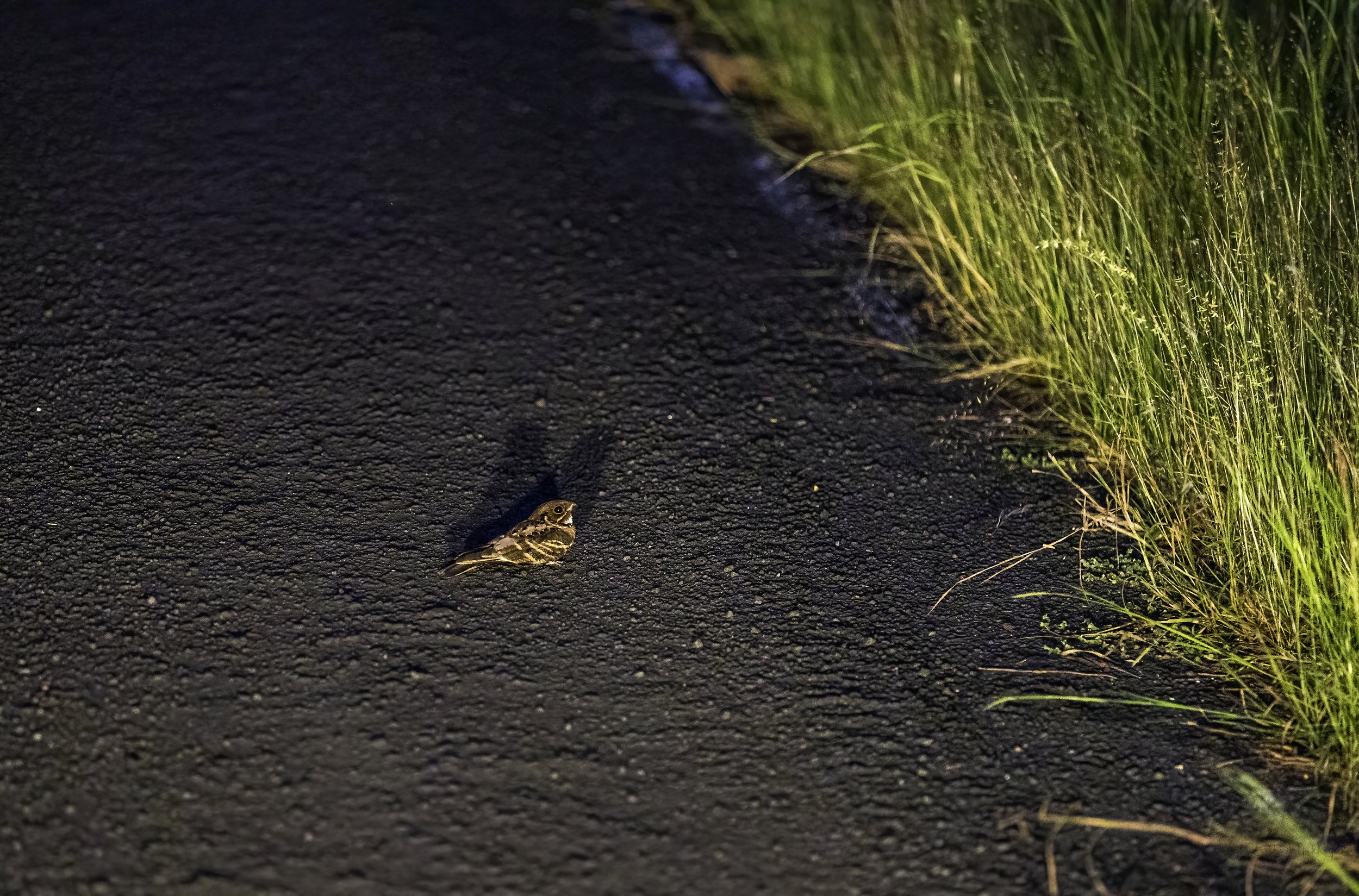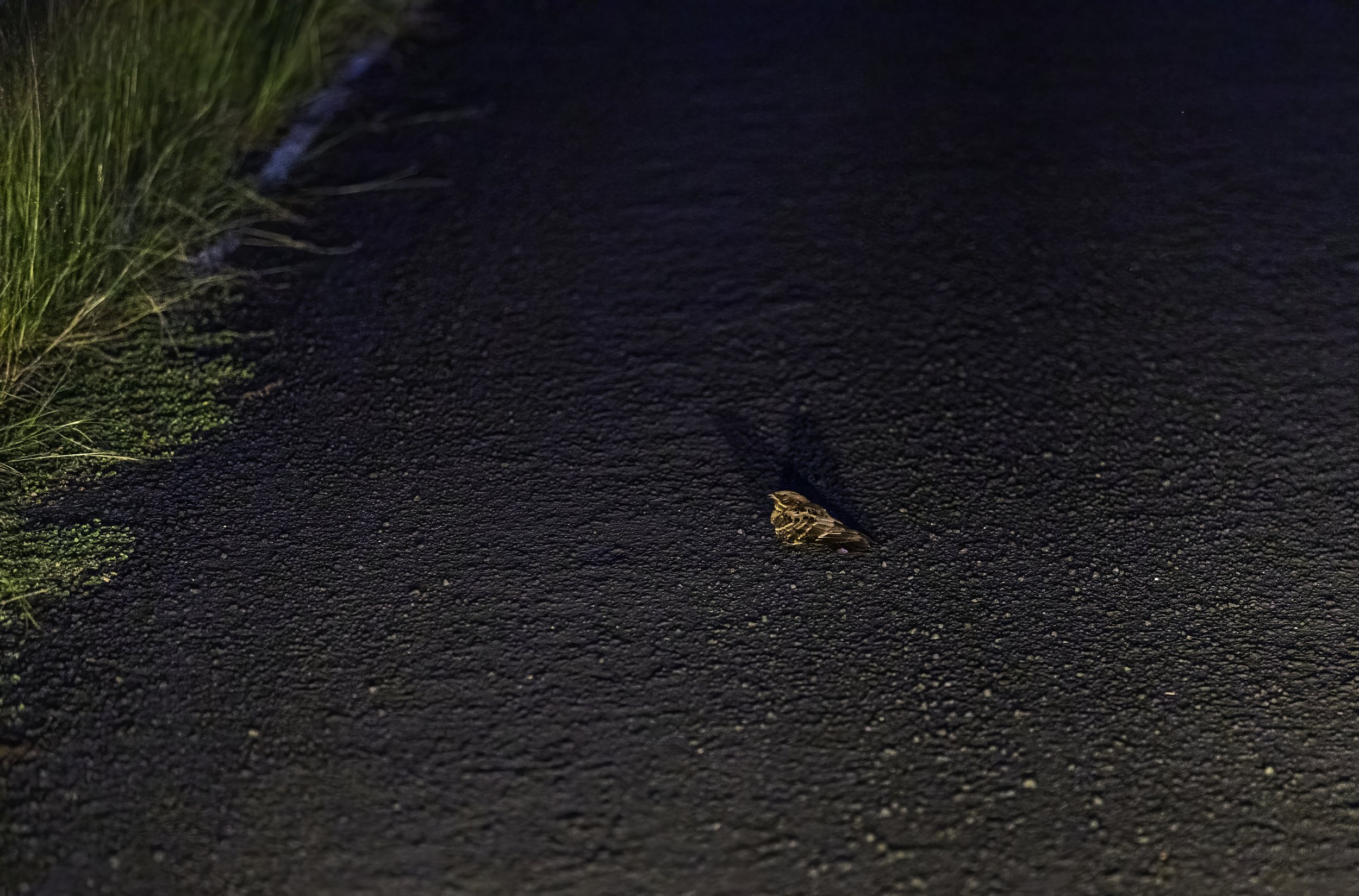Large-tailed Nightjar
Caprimulgus macrurus
Tadoba Andhari National Park
As the day ends, the natural world’s night shift kicks into gear and many of our best-loved animals and birds become active. But thankfully you don’t need to be an insomniac to work at night. To shoot wildlife photos at night, please understand that the process is more complicated than doing it during the day. Aside from the safety, one will need to adjust the camera settings appropriately to be able to get excellent images even in the dark.
First and foremost, it’s important to know that once you head out into the jungle at night, you’re entering a completely different world. Predators are more active, the cacophony of the day has dissipated and the night has its own symphony which can be both unnerving and relaxing at the same time. And the most crucial aspect is - the light - because depending on the moon phase, visibility can be next to non-existent. The headlights of the safari vehicle and/ or a sweeping spotlight are all you have to spot the ever-bustling life that’s now cloaked in darkness. This is exhilarating!
At night, animals and birds are found, for the most part, by the light being reflected by their eyes, and there’s nothing more adrenalin pumping than turning a corner and seeing bright eyes gleaming back at you. After that heartbeat of excitement comes curiosity, and of course all fingers become crossed for the likes of a big cat. Night drives are an experience, and one that I feel everyone should have when visiting the jungles of India, and a successful one will have you addicted to traversing these beautiful landscapes at night.
Taking photographs at night has a magic all of its own, but there are some obvious challenges, the biggest being the lack of light. The biggest difference between daytime and night photography is the exposure values in use. The darkness changes everything! So we need to add some light by using a flash or torch, or try to work with available light either from the headlights of the safari vehicle or a spotlight or in some cases even the moon. To do so successfully one will need to know the temperature of the light that is available. Also known as colour appearance, colour temperature refers to how warm or cool light appears and the night is cool.
ISO values are also important and invariably setting high ISO values will make the difference when using natural light at night, but be careful of creating too much ‘noise’ in your images. Many modern digital cameras have their own flash built-in, but I would suggest that you buy a more powerful flash gun or use a reasonably powerful spotlight. This will allow you to illuminate the animal with full flash, or use a more subtle light (fill flash) that blends the background into the image.
Finally, try to think outside the box. You don’t always need to fully light your subject: silhouettes are just as effective, as are backlit images.
Shooting in the wild at night may not only be uncomfortable for us as photographers, but it is certainly uncomfortable for the nocturnal subjects too. Using artificial light could frighten these animals and even affect their night vision. For this reason, whether one uses prolonged light like a spotlight or a quicker light, such as flash, just do not stay for a long time.
Moreover, if you have to shoot a stationary subject, like this Large-tailed Nightjar, you do not have to take hundreds of images. Turn off the light immediately, until you need to shoot again, like when it is moving or changing to a better position.
For some spectacular nocturnal images do visit one of my favourite photographers here.
Now on to the Large-tailed Nightjar we spotted perched on the road near the famous Telia Lake. The following photos were taken in the light from the headlights of our safari vehicle.
I have written more about the Telia Lake region in an earlier blog - A Tigress and her Cubs.
Tadoba National Park - The Telia Lake Region
Soon after entering the Moharli gate one enters the realm of some of the main protagonists of Tadoba and a kingdom of warfare - the Telia Lake region. Here some of the bloodiest battles were fought for dominance of the lush lands rich with prey and graceful ladies. We start with Madhuri who, in 2010, delivered her first litter with Broken Tail (Yeda Anna). This litter did not survive and were killed by the huge Wagdoh male who defeated Yeda Anna. Wagdoh then sired Madhuri’s second litter, Sonam, Lara, Geeta & Mona - the Telia Sisters - made famous by a documentary on their growing up aired by the Discovery Channel on 20 September, 2014 as “Tigress Blood” and also telecast on Indian television in early 2015 as “Tiger Sisters of Telia“ capturing the extraordinary behaviour of these four tiger sisters entrenched around the Telia Lake and their unique adaptation to survive. This was a coming-of-age story, filmed over two years, of sisters who battled each other for dominance over their homeland. Once the girls grew older and stronger, instinct kicked in and they had to separate and compete to take their mother’s place for control of Telia Lake. Their bond was broken and the family torn apart. To survive independently, each sister had to make one large kill every week – and alone, they each struggled. Desperate and starved, the four siblings made a startling choice — to form an alliance. They joined forces to hunt as a pack, fearless and unstoppable, and take on dangerous prey, culminating in a never-before-filmed hunt of a tiger family taking down a sloth bear and forever changing the rules of tiger behaviour.
Of the four Sonam was the most aggressive and dominant. She later chased away her three sisters and mother Madhuri and ruled around the Telia lake. She delivered her first litter here and as we listened to this extraordinary tale in awe, we spotted something on the road, barely visible on the outer fringes of our headlights. The jungle was alive with the sounds of the night and we inched closer to find a pair of large-tailed nightjars perched in the middle of the road.
These are a few photos we got that night - all taken from the gypsy as it is not advisable to get off the vehicle while in the jungle, especially more so at night.
‡‡‡‡‡
This photo has a bug flying just beyond the plane of focus as well - dinner!
Large-tailed Nightjar
The Large-tailed Nightjar (Caprimulgus macrurus) is a species of nightjar in the family Caprimulgidae. It is an intricately patterned nocturnal bird, usually found roosting on the ground or a low branch in open forest, secondary growth, and cultivated areas. A brownish gray overall, with a rich brown ear patch and chestnut-and-black dappled wings. The bright white tail corners can be seen when it is flushed. It is sometimes found in parks and gardens, where it hawks for insects below street lamps. It is found along the southern Himalayan foothills, eastern South Asia, Southeast Asia and northern Australia. This species is a resident of the countries of Australia, Bhutan, Bangladesh, Brunei, Cambodia, China, India, Indonesia, Laos, Malaysia, Myanmar, Nepal, Pakistan, Papua New Guinea, Philippines, Singapore, Thailand, Timor-Leste and Vietnam. Within this range they are generally sedentary, showing only small local movements. Its natural habitats are subtropical or tropical moist lowland forest, subtropical or tropical mangrove forest, and subtropical or tropical moist montane forest.
In Malaysia it is known to frequent cemeteries at night, hence its rather macabre common name burung tukang kubur ("graveyard nightjar")
The Large-tailed Nightjar is a large bird measuring 25 to 33 cm in length and weighing 55 to 78 grams. It has an overall greyish-brown plumage which provides excellent camouflage in leaf litter. It has a white throat patch and buffy underparts which are finely streaked with dark bars. Distinctively, the wingtips of the Large-tailed Nightjar fall half-way along the length of the tail when the bird is at rest.
The Large-tailed Nightjar exhibits sexual dimorphism. The adult male has distinct white patches on the outer primary feathers and broad white tips on two outer tail feathers. The wing patches and tail patches on the female are smaller and narrower, and generally more buff coloured, than those on the male. These wing patches are most distinctive in flight.
Juvenile birds look similar to the female but are overall paler and more buff-coloured. The tail patches on the juvenile are less distinct and duskier than those in the adult.
The call of the Large-tailed Nightjar is a loud hollow monotonous “chonk”, as if knocking on wood. This is repeated with pauses in between the notes and can be heard throughout the night. This gives rise to their common name of “Carpenter Birds”.
There are six subspecies currently recognized:
ssp. albonotatus – found in the foothills of the Himalayas, eastwards from north-east Pakistan to Bhutan and north-east India and southwards to east India and Bangladesh.
ssp. bimaculatus – found in extreme north-eastern parts of India, eastwards to southern China and southwards throughout Southeast Asia to Sumatra and the Riau Archipelago
ssp. johnsoni – found in the southern Philippines
ssp. salvadorii – found in Borneo and the southern Sulu Islands
ssp. macrurus – found in Java and Bali
ssp. schlegelii – found in the Moluccas, Flores Sea and the Western Lesser Sundas, through the Bismarck Archipelago, south to the coastal areas of northern and north-eastern Australia
An interesting fact is that these Large-tailed Nightjars do not build a nest, instead they simply lay 1 to 2 mottled pinkish eggs in a shallow depression in the ground. The location of the nest site is usually in a shaded area under a tree or bush. Like the parent birds, the eggs are perfectly camouflaged, looking like small pebbles. Both parents incubate the eggs over a period of 16 to 18 days, the female mostly during the day and the male mostly at night.
Large-tailed Nightjars are highly nocturnal and will remain motionless on the ground, often very well camouflaged in leaf-litter, during the day. But sometimes they have also been spotted perched on tree branches where they can camouflage against the tree bark. In addition to acting as a scoop for food, the large extendable bill of the Large-tailed Nightjar can suddenly open to show the brightly coloured mouth interior. It is thought that this behaviour can be used to startle potential predators, providing opportunity for the bird to escape.
The Large-tailed Nightjar is currently not considered to be under conservational risk, although loss of habitat through disruption and destruction is a threat.
With that said lets move on to the gallery of the Large-tailed Nightjar from this incidental encounter.
‡‡‡‡‡
Related Posts














